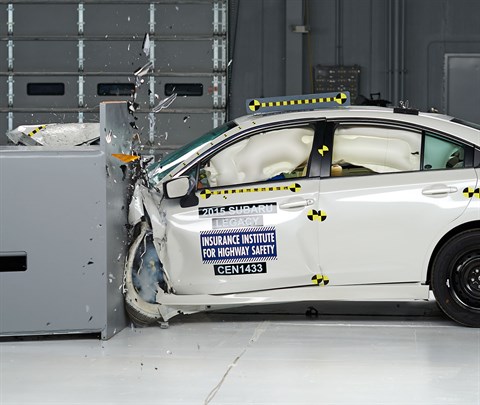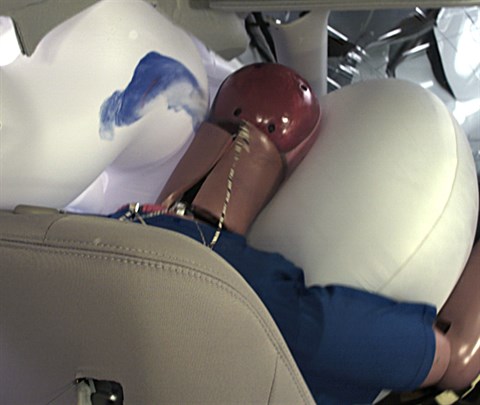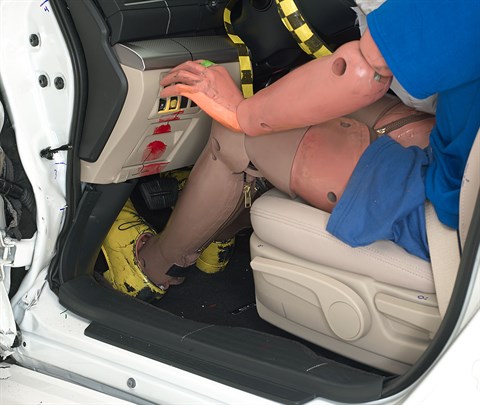Small overlap front: driver-side
Rating applies to 2015-19 models
Tested vehicle: 2015 Subaru Legacy 2.5i 4-door 4wd
The Subaru Legacy was redesigned for the 2015 model year. The driver-side small overlap frontal crash test ratings also apply to the station wagon version of the Legacy, known as the Outback, also redesigned for 2015.
| Evaluation criteria | Rating |
|---|---|
| Structure and safety cage | |
| Driver injury measures | |
| Head/neck | |
| Chest | |
| Hip/thigh | |
| Lower leg/foot | |
| Driver restraints and dummy kinematics | |

Action shot taken during the driver-side small overlap frontal crash test.

The dummy's position in relation to the door frame, steering wheel, and instrument panel after the crash test indicates that the driver's survival space was maintained very well.

The frontal and side curtain airbags worked well together to keep the head from coming close to any stiff structure or outside objects that could cause injury.

The driver's space was maintained well, and risk of injuries to the dummy's legs and feet was low.
Moderate overlap front: original test
Rating applies to 2015-19 models
Tested vehicle: 2015 Subaru Legacy 2.5i Premium 4-door 4wd
The Subaru Legacy was redesigned for the 2015 model year. Moderate overlap frontal ratings are assigned by the Institute based on a test conducted by Subaru.
The moderate overlap frontal crash test ratings also apply to the station wagon version of the Legacy, known as the Outback, also redesigned for 2015.
| Evaluation criteria | Rating |
|---|---|
| Overall evaluation | |
| Structure and safety cage | |
| Driver injury measures | |
| Head/neck | |
| Chest | |
| Leg/foot, left | |
| Leg/foot, right | |
| Driver restraints and dummy kinematics | |
Side: original test
Rating applies to 2015-19 models
Tested vehicle: 2015 Subaru Legacy 2.5i Premium 4-door 4wd with standard front and rear head curtain airbags and standard front seat-mounted torso airbags
The Subaru Legacy was redesigned for the 2015 model year. Side ratings are assigned by the Institute based on a test conducted by Subaru.
| Evaluation criteria | Rating |
|---|---|
| Overall evaluation | |
| Structure and safety cage | |
| Driver injury measures | |
| Head/neck | |
| Torso | |
| Pelvis/leg | |
| Driver head protection | |
| Rear passenger injury measures | |
| Head/neck | |
| Torso | |
| Pelvis/leg | |
| Rear passenger head protection | |
Roof strength
Rating applies to 2015-19 models
Tested vehicle: 2015 Subaru Legacy 2.5i 4-door 4wd
Rating applies to both the Subaru Legacy (tested) and the structurally similar Subaru Outback.
| Overall evaluation | |
|---|---|
| Curb weight | 3,455 lbs |
| Peak force | 18,533 lbs |
| Strength-to-weight ratio | 5.36 |
Head restraints & seats
Seat type: Power cloth seat
| Overall evaluation | |
|---|---|
| Dynamic rating | |
| Seat/head restraint geometry |
About the head restraint & seat test
Currently, IIHS tests apply only to front seats.
Headlights
Ratings are given for 8 different headlight variations available on this vehicle.
Trim level(s)
- 2.5i Premium trim equipped with EyeSight Driver Assist Technology package
- 2.5i Sport trim equipped with EyeSight Driver Assist Technology package
| Evaluation criteria | Rating |
|---|---|
| Low-beam headlight type | Halogen projector |
| High-beam headlight type | Halogen reflector |
| Curve-adaptive? | Yes |
| High-beam assist? | Yes |
|
Overall rating | |
| Distance at which headlights provide at least 5 lux illumination: | |
Low beams
On the straightaway, visibility was good on the left side of the road and fair on the right side. On curves, visibility was fair on the sharp right and sharp left curves and inadequate on the gradual right and gradual left curves.
The low beams created some glare.
High beams
On the straightaway, visibility was good on the right side of the road and fair on the left side. On curves, visibility was fair on the gradual right and gradual left curves and inadequate on the sharp right and sharp left curves.
High-beam assist compensates for some limitations of this vehicle's low beams on the straightaway, on both left curves and on both right curves.
Trim level(s)
- 2.5i trim
- 2.5i Premium trim
- 2.5i Limited trim
- 2.5i Sport trim
| Evaluation criteria | Rating |
|---|---|
| Low-beam headlight type | Halogen projector |
| High-beam headlight type | Halogen reflector |
| Curve-adaptive? | No |
| High-beam assist? | No |
|
Overall rating | |
| Distance at which headlights provide at least 5 lux illumination: | |
Low beams
On the straightaway, visibility was good on the left side of the road and fair on the right side. On curves, visibility was inadequate in all 4 tests.
The low beams created some glare.
High beams
On the straightaway, visibility was good on the right side of the road and fair on the left side. On curves, visibility was fair on the gradual right and gradual left curves and inadequate on the sharp right and sharp left curves.
Trim level(s)
- 2.5i Limited trim equipped with EyeSight Driver Assist Technology package; built before August 2016
- 3.6R Limited trim equipped with EyeSight Driver Assist Technology package; built before August 2016
| Evaluation criteria | Rating |
|---|---|
| Low-beam headlight type | HID projector |
| High-beam headlight type | Halogen reflector |
| Curve-adaptive? | Yes |
| High-beam assist? | Yes |
|
Overall rating | |
| Distance at which headlights provide at least 5 lux illumination: | |
Low beams
On the straightaway, visibility was good on both sides of the road. On curves, visibility was good on both right curves and fair on both left curves.
The low beams created some glare.
High beams
On the straightaway, visibility was good on the right side of the road and fair on the left side. On curves, visibility was good on the gradual right curve and fair on the sharp right and both left curves.
High-beam assist compensates for some limitations of this vehicle's low beams on the straightaway, on both left curves and on the sharp right curve.
Trim level(s)
- 2.5i Limited trim equipped with EyeSight Driver Assist Technology package; built after November 2016
- 3.6R Limited trim equipped with EyeSight Driver Assist Technology package; built after November 2016
| Evaluation criteria | Rating |
|---|---|
| Low-beam headlight type | HID projector |
| High-beam headlight type | Halogen reflector |
| Curve-adaptive? | Yes |
| High-beam assist? | Yes |
|
Overall rating | |
| Distance at which headlights provide at least 5 lux illumination: | |
Low beams
On the straightaway, visibility was good on both sides of the road. On curves, visibility was good on both right curves and fair on both left curves.
The low beams created some glare.
High beams
On the straightaway, visibility was good on the right side of the road and fair on the left side. On curves, visibility was good on the gradual right curve and fair on the sharp right and both left curves.
High-beam assist compensates for some limitations of this vehicle's low beams on the straightaway, on both left curves and on the sharp right curve.
Trim level(s)
- 3.6R Limited trim; built before August 2016
| Evaluation criteria | Rating |
|---|---|
| Low-beam headlight type | HID projector |
| High-beam headlight type | Halogen reflector |
| Curve-adaptive? | No |
| High-beam assist? | No |
|
Overall rating | |
| Distance at which headlights provide at least 5 lux illumination: | |
Low beams
On the straightaway, visibility was good on both sides of the road. On curves, visibility was good on both right curves, fair on the sharp left curve and inadequate on the gradual left curve.
The low beams created some glare.
High beams
On the straightaway, visibility was good on the right side of the road and fair on the left side. On curves, visibility was good on the gradual right curve and fair on the sharp right and both left curves.
Trim level(s)
- 3.6R Limited trim; built after November 2016
| Evaluation criteria | Rating |
|---|---|
| Low-beam headlight type | HID projector |
| High-beam headlight type | Halogen reflector |
| Curve-adaptive? | No |
| High-beam assist? | No |
|
Overall rating | |
| Distance at which headlights provide at least 5 lux illumination: | |
Low beams
On the straightaway, visibility was good on both sides of the road. On curves, visibility was good on both right curves, fair on the sharp left curve and inadequate on the gradual left curve.
The low beams created some glare.
High beams
On the straightaway, visibility was good on the right side of the road and fair on the left side. On curves, visibility was good on the gradual right curve and fair on the sharp right and both left curves.
Trim level(s)
- 2.5i Limited trim equipped with EyeSight Driver Assist Technology package; built after July 2016 and before December 2016
- 3.6R Limited trim equipped with EyeSight Driver Assist Technology package; built after July 2016 and before December 2016
| Evaluation criteria | Rating |
|---|---|
| Low-beam headlight type | HID projector |
| High-beam headlight type | Halogen reflector |
| Curve-adaptive? | Yes |
| High-beam assist? | Yes |
|
Overall rating | |
| Distance at which headlights provide at least 5 lux illumination: | |
Low beams
On the straightaway, visibility was fair on both sides of the road. On curves, visibility was good on both right curves, fair on the sharp left curve and inadequate on the gradual left curve.
The low beams never exceeded glare limits.
High beams
On the straightaway, visibility was good on the right side of the road and fair on the left side. On curves, visibility was good on the gradual right curve, fair on the sharp right and gradual left curves, and inadequate on the sharp left curve.
High-beam assist compensates for some limitations of this vehicle's low beams on the straightaway, on both left curves and on the gradual right curve.
Trim level(s)
- 3.6R Limited trim; built after July 2016 and before December 2016
| Evaluation criteria | Rating |
|---|---|
| Low-beam headlight type | HID projector |
| High-beam headlight type | Halogen reflector |
| Curve-adaptive? | No |
| High-beam assist? | No |
|
Overall rating | |
| Distance at which headlights provide at least 5 lux illumination: | |
Low beams
On the straightaway, visibility was fair on both sides of the road. On curves, visibility was good on both right curves, fair on the sharp left curve and inadequate on the gradual left curve.
The low beams never exceeded glare limits.
High beams
On the straightaway, visibility was good on the right side of the road and fair on the left side. On curves, visibility was good on the gradual right curve, fair on the sharp right and gradual left curves, and inadequate on the sharp left curve.
Front crash prevention: vehicle-to-vehicle
Child seat anchors
Rating applies to 2016-17 models
| Evaluation criteria | Rating |
|---|---|
| Overall evaluation | |
| Vehicle trim | 3.6R Limited |
| Seat type | leather |
This vehicle has 2 rear seating positions with complete child seat attachment (LATCH) hardware.
It has 1 additional seating position with a tether anchor only.
| Evaluation criteria | Rating |
|---|---|
| Overall evaluation | |
| Vehicle trim | 3.6R Limited |
| Seat type | leather |
| Rating icon | Rating |
|---|---|
| G | Good |
| A | Acceptable |
| M | Marginal |
| P | Poor |
| Seating positions that rely on borrowed lower anchors or have only a tether anchor available are not rated. | |
thether anchor symbol | Tether anchor |
lower anchor symbol | Lower anchors |
| Lower anchor(s) can be borrowed from adjacent positions(s) | |
| No hardware available |
Details by seating position
| Position | Rating |
|---|---|
| 1 | |
| Tether anchor | |
| easy-to-find location | |
| no other hardware could be confused for anchor | |
| Lower anchors | |
| too deep in seat | |
| not too much force needed to attach | |
| easy to maneuver around anchors | |
| 2 | |
| Tether anchor | |
| easy-to-find location | |
| no other hardware could be confused for anchor | |
| Lower anchors | |
| none available | |
| 3 | |
| Tether anchor | |
| easy-to-find location | |
| no other hardware could be confused for anchor | |
| Lower anchors | |
| too deep in seat | |
| not too much force needed to attach | |
| easy to maneuver around anchors |
